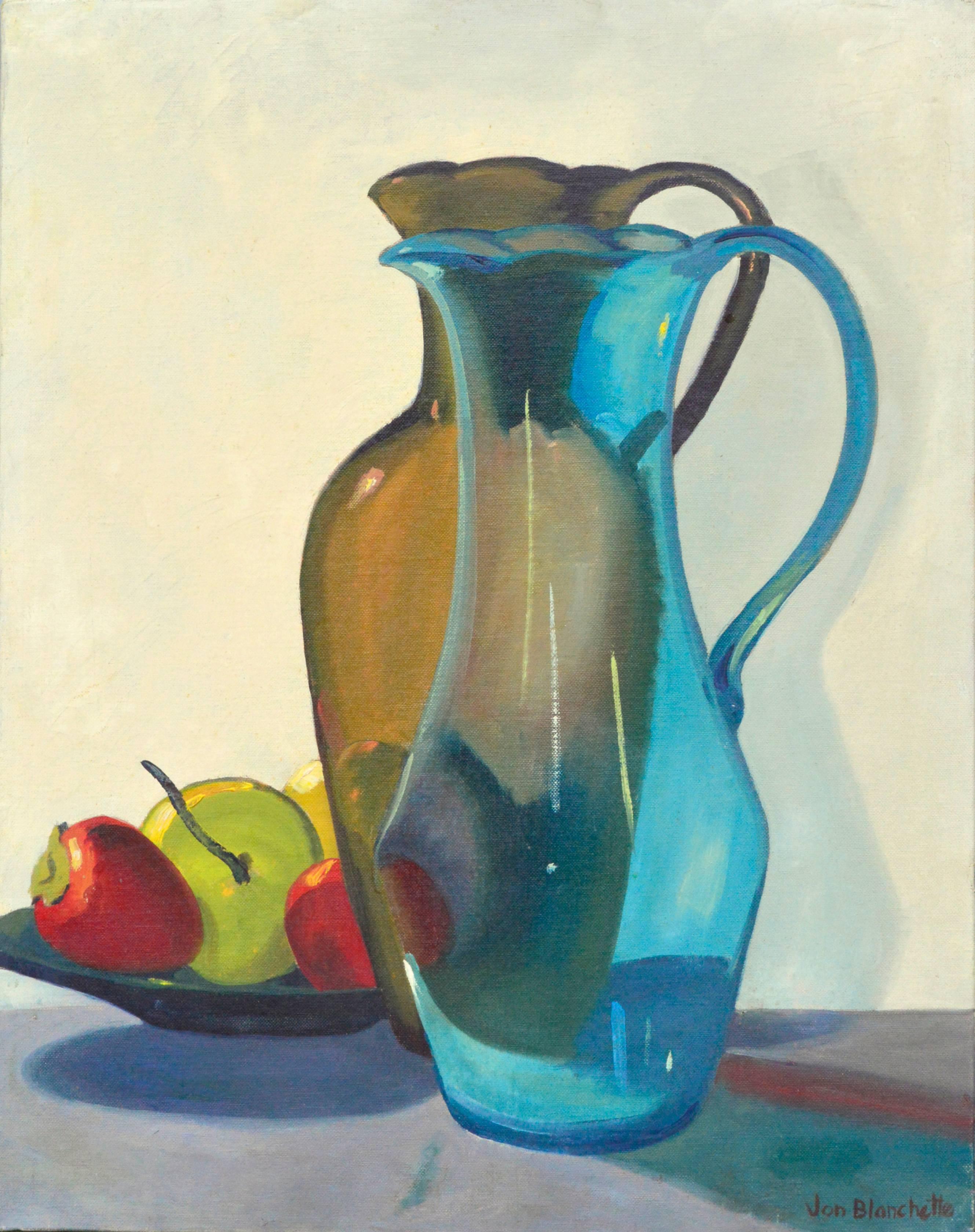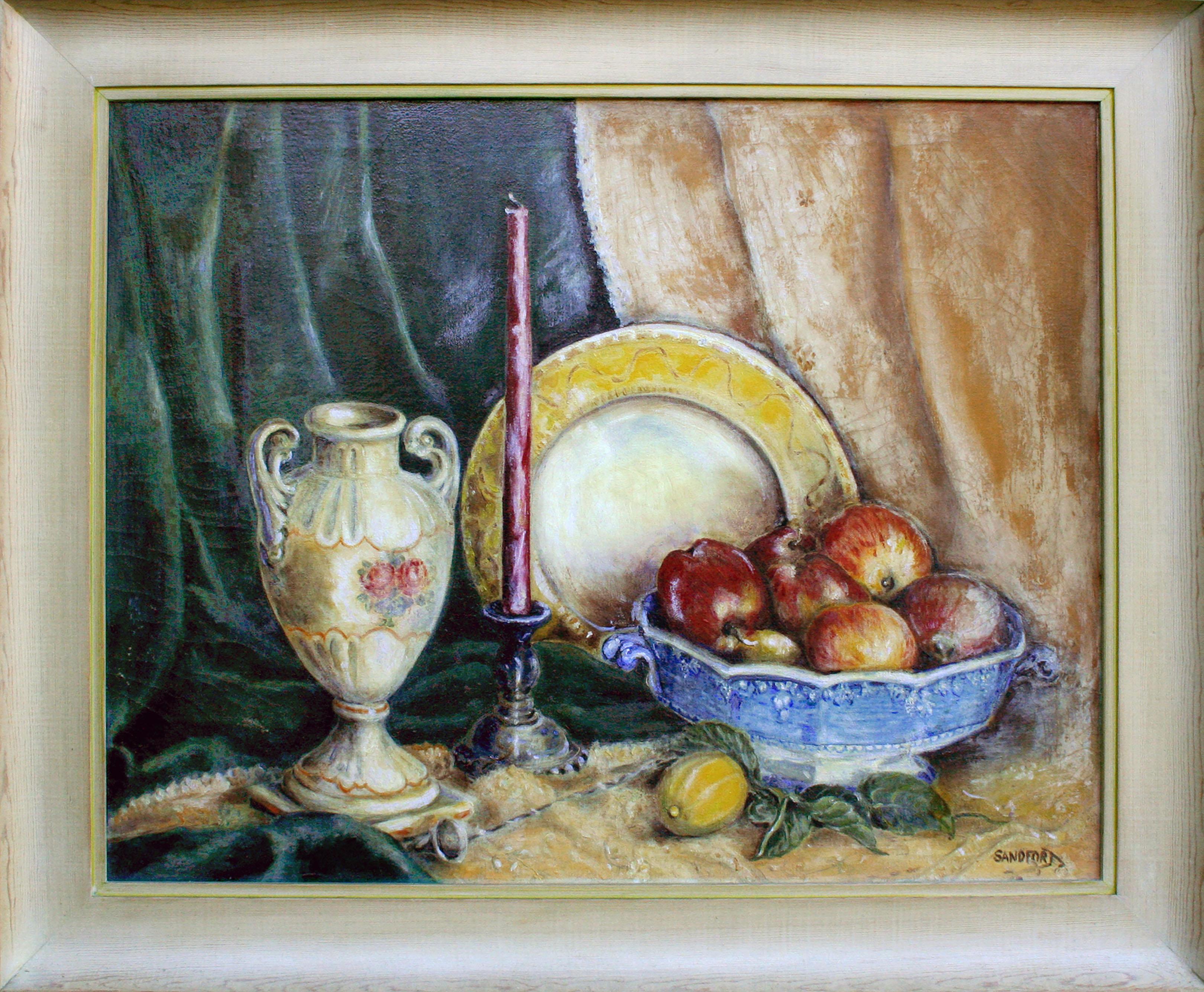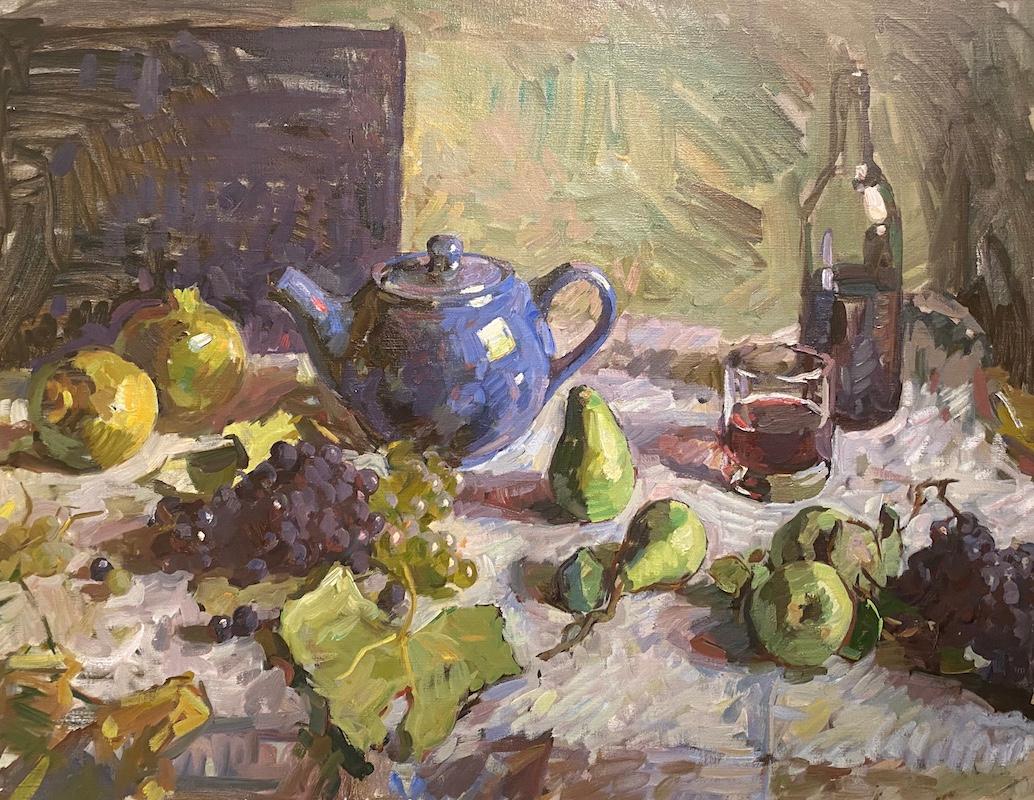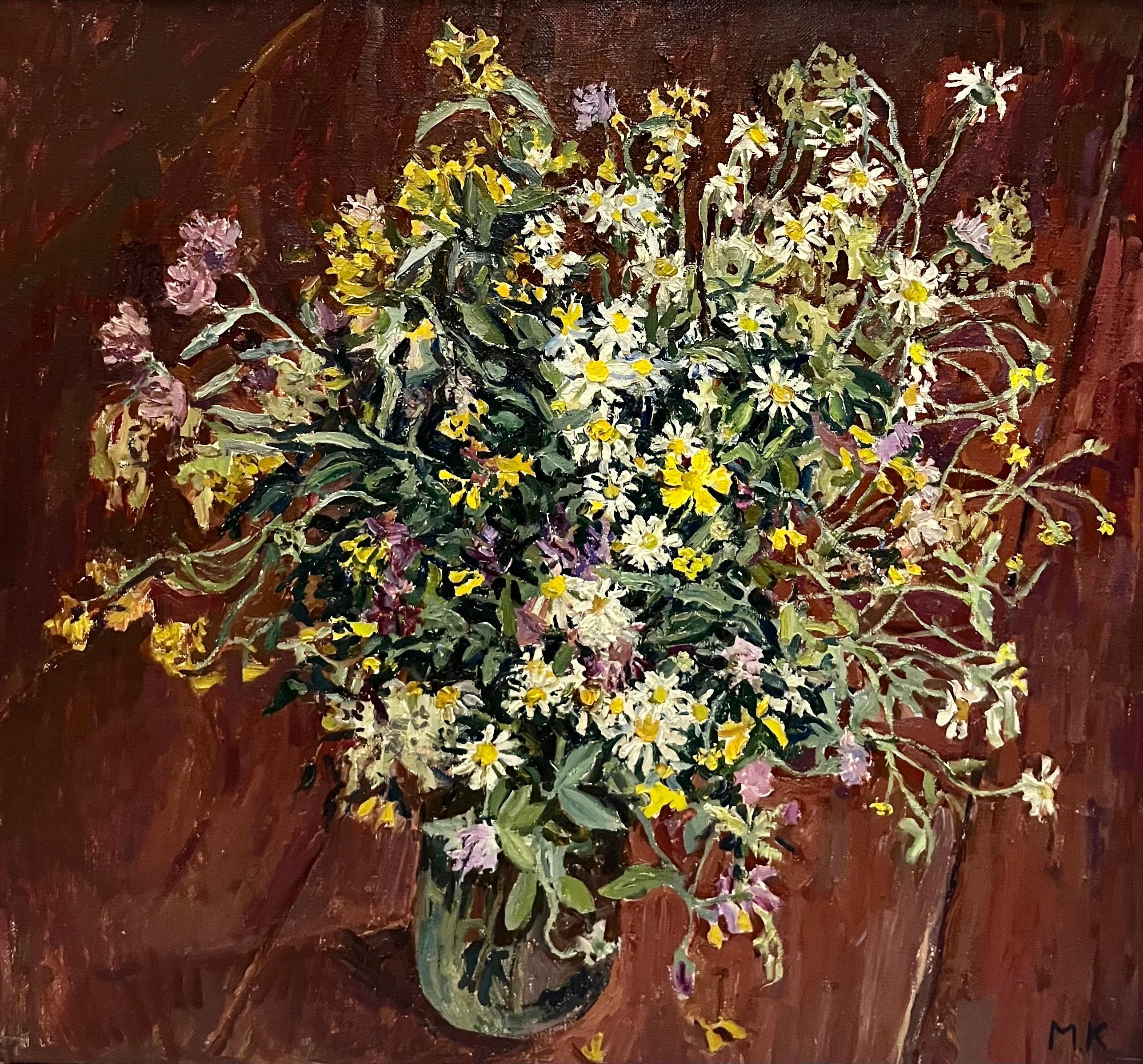Items Similar to Grand Still Life
Want more images or videos?
Request additional images or videos from the seller
1 of 7
Fernand ToussaintGrand Still Life1920
1920
About the Item
Documentation Signed
Origin Belgium
Period 1920-1949
Materials oil on canvas
Dimensions
W. 25.5 in; H. 31 in;
W. 64.77 cm; H. 78.74 cm;
Condition Good. Excellent condion
Creation Date C. 1930
Description An exquisite still life with masterful use of color.
Carved frame measures 38.5 x 33 inches.
Fernand Toussaint was born in Brussels 1873. He is remembered for his still-lifes and figurative subjects.
At the age of fifteen he entered the Academy of Fine Arts of his native city where he studied under Jean Portaels, an innovative and demanding teacher who attached prime importance to the art of drawing. Thus Toussaint received thorough formal academic training before leaving for Paris in 1891 where he completed his studies. There he met the great Alfred Stevens, who was then at the height of his artistic popularity, and with Stevens' guidance, Toussaint formulated his own individual style, combining elegance and fine draftsmanship with a free impressionistic handling of paint.
He exhibited widely at most of the major venues in Brussels, and at the Salon des Artistes Francais in Paris, where he received a medal in 1901 and a gold medal in 1929.
Fernand Toussaint passed away in 1956.
Styles / Movements Impressionism
- Creator:
- Creation Year:1920
- Dimensions:Height: 31 in (78.74 cm)Width: 25.5 in (64.77 cm)Depth: 4 in (10.16 cm)
- Medium:
- Movement & Style:
- Period:
- Condition:
- Gallery Location:Los Angeles, CA
- Reference Number:1stDibs: LU395463991
About the Seller
5.0
Vetted Seller
These experienced sellers undergo a comprehensive evaluation by our team of in-house experts.
Established in 1972
1stDibs seller since 2011
Typical response time: <1 hour
- ShippingRetrieving quote...Ships From: Los Angeles, CA
- Return PolicyThis item cannot be returned.
More From This SellerView All
- STILL LIFE WITH FROWERSBy Philip ReismanLocated in Los Angeles, CAPHILIP REISMAN "STILL LIFE WITH FROWERS" OIL ON PANEL. SIGNED AMERICAN, C.1935 20 X 16 INCHES Philip Reisman 1904-1992 Philip Reisman was born July 18, 1904 in Warsaw, Poland....Category
1930s Impressionist Still-life Paintings
MaterialsOil, Panel
- PhotosynthesisBy Lorena VillalobosLocated in Los Angeles, CAPainted in 2012 for the Exhibition entitled "Ecological S.O.S.", at the 1887 Gallery of the Museum of Art and Design, San Jose, Costa Rica. Lorena Villalobos, with more than a hundre...Category
21st Century and Contemporary Abstract Impressionist Abstract Paintings
MaterialsCanvas, Acrylic
- The StudioLocated in Los Angeles, CALarge watercolor and mixed media work Original frame. “Keith Finch was born in Holyoke, Colorado in 1920 but has lived in Los Angeles, where he attended the elementary grades and h...Category
1950s Contemporary Mixed Media
MaterialsMixed Media
- AnitaLocated in Los Angeles, CAAttached is “Anita” (1916), by William Cahill (1878-1924), oil on artist board, 14 x 14 inches, signed & dated l/r. Exhibited at the Salmagundi Club, 1...Category
1910s Impressionist Figurative Paintings
MaterialsOil, Panel
- Lady in the Paris ParkLocated in Los Angeles, CABeautiful young lady in a Paris Park, signed, Original Frame, listed size includes the frame.Category
1950s Impressionist Figurative Paintings
MaterialsPanel, Oil
- BLONDE WITH ART DECO NECKLACELocated in Los Angeles, CABiography from the niece of the artist from during his lifetime. Paintings acquired from the artist.s estate. Max Turner 1925 - 2019 Max Lamar Turner Painter, Sculptor, Teacher and Author. Max Turner was born in Omaha, Nebraska on July 28, 1925. His father was Lance Howard Turner and his mother Mary Irene Turner. In 1927, his family moved to Bingham Canyon, Utah where Max's father extracted copper from a creek that he had diverted to pass through his garage. The town was located in a narrow canyon on the eastern face of the Oquirrh Mountains. In 1938, when Max was 13, his family moved to Midvale, Utah. After completing high school, Max went to work laying rail until he was inducted into the U.S. Navy to serve during W.W. II. There he took an aptitude test and was initially assigned to the medical corp., later transferring to the dental unit. Max was stationed at Port Hueneme, Ventura County, California through the end of the war. When he was discharged in 1946, he remained in Southern California, living in the Los Angeles area. He met a man named Larry Torres and they formed a partnership to do silk screen work primarily for the Colby Poster Printing Company. This lasted about 10 years until the Colby building caught fire and burned down. In 1958, Max began working for Slade Novelty company that made doll parts using a product called plastisol. A year later, Max began producing plastic parts through his own business. One day, a couple of kids brought in a shrunken skull they had made and asked Max if he could reproduce it. Max said he could and he looked around for a business to work with for this task. He ultimately decided he could create his own machine shop to make molds. As a result, Max purchased a lathe, drill press, grinder and other tools to create his own machine shop and went into business making molds. He built a clientele and in 1973, he moved his machine shop to Glendale, California. Painter, Sculptor, Teacher and Author: Max recalls the day when his interest in art took a new direction. He happened to be in a paint store to purchase some supplies when he saw a card posted on a wall that read, "Come paint with Connie Marlo". Max had been interested in art since his youth and he was frequently impressed with paintings displayed by local artists at various community events. Consequently, he decided to go to Connie's Saturday morning art class at a studio on North La Brea Avenue (between Sunset and Hollywood) in Los Angeles. But, as fate would have it, he immediately took a detour from this class when he found a piece of paper on the floor of the studio referencing another art class dealing with compositions, patterns, rhythms and color harmony. The instructor's name was Hal Reed, a former art student of the Russian/American Master, Nicolai Fechin. Hal owned the building (previously the Will Foster Studio) and had founded the Art League of Los Angeles. When Max found Hal, he asked Hal if he could join his class. Hal said "No, the class was full" but he said Max could monitor the class in the back of the classroom. Max took him up on the offer and began observing the weekly class. During the class, Hal told his students that they should practice what they were learning by going to "live model" classes. Max began attending these classes where he learned how to draw figures. After a few months, Hal and Max became good friends. Hal was so impressed with Max's work that he offered Max the opportunity to teach at another location that Hal was opening in the San Fernando Valley. Max accepted the offer and began teaching his own art class. For Max, it was a quick jump from learning to teaching. Max then found that several of his students had to commute to his art class from the west end of the "Valley". To better serve this group of students, Max decided to relocate to another studio in Calabasas. Max continued teaching, and at this time he was producing very impressive portraits, both oil paintings and charcoal drawings from live models (Max never worked from photos). Max demonstrated real talent, and the style of his drawings and paintings were being compared to those of Nicolai Fechin. And, like Fechin, Max also had an interest in sculpting. One day, Max decided to design and cast a bronze owl sculpture to put in his Calabasas Fine Art Gallery. Later, someone approached Max when he was at the foundry and asked him about his success selling the owl sculpture. The individual who asked this question was convinced that there was a broader market for these sculptures and he ordered a dozen of the owl sculptures from Max. This encouraged Max to do more castings. Some of the new castings were antique sculptures he found and reproduced. As this new business grew, he decided to establish his own foundry, employing up to 15 workers. The business continued for many years, up until the late 1990's when Max got tired of the foundry business and sold it. Max, who was now in his 70's, decided to move on to his next venture as an artist, dedicating himself to doing the actual sculpting of original art. He loved the creativity of sculpting and he had his sculptures cast at local foundries, ironically the same ones that used to be his competition. Max was now fully engaged in his new artistic direction and, over time, he produced a large body of work. He created very impressive sculptures, including about 100 full-size sculptures. He sold some of these to high-end clientele, the Foundry at SLS Las Vegas, and to Hollywood studios. Even though Max now seemed to be totally in his element, he somehow also found time to continue to teach painting classes at the California Art Institute in Westlake Village in Los Angeles. At the institute, he specialized in figure work. Max continued to draw, paint and teach, but he says he stopped sculpting when he turned 90. Max produced four books showcasing his drawings and paintings. The first is "Faces, The Drawings of Max Turner", copyright 2000, that showcases nearly 100 of his portrait drawings. Within the "Acknowledgements" section, he lists Hal Reed and Joseph Nordmann, two former students of Nicolai Fechin. In 2006, Max produced his second book titled "Figures and Faces", reflecting not only portraits but also figure drawings and paintings. It is a wonderful book of Max's work, but it is currently difficult to find. The third book is titled "Faces 2, The Paintings and Drawings of Max Turner", copyright 2009, which includes 75 portrait paintings and drawings. In the "Preface" of this book, Max describes growing up in a small and isolated mining town during the Great Depression. He states that as a kid, he had little exposure of any culture or view of what the rest of the world was like. His neighbor was the trash collector and Max would sometimes go through his truck looking for anything of value. Among other things, he found magazines like Cosmopolitan, Good Housekeeping and Red Book, with covers that frequently showed drawings or paintings of faces. Max states that these images were the very first source of inspiration for him. He says that he began looking more carefully at people's faces and if they had character, he would draw them. By drawing them, Max says that he was making them part of his world, his world of "Faces". In 2018, Max published his newest book showcasing his drawings and paintings. It is titled "Max Turner's Figure Sketches". This softbound book includes 76 pages and over 120 drawings and paintings. In the Introduction, Max explains "I have found that when approaching the figure, one should begin with the gesture. After having captured the essence or feeling of the pose, one can then proceed to build on it." The figure sketches in this wonderful book reflect a Master's work that consistently captures the "gesture"-showing the emotion, movement and expression. Two more books are on the horizon for Max, both dealing with his passion for sculpting. His first, "The Sculpture of Max Turner" is a compilation of his commercial and noncommercial pieces throughout his career. The second, "Terra Cotta Sculpture by Max Turner" is a complete collection of figures done at the California Art Institute. These much anticipated books should be out later in 2018. Max now considers himself primarily a sculptor. But others in the art world are more than impressed with his drawings and paintings as well. His portraits are often described as having a Fechin-esque appearance, referring to the style of Nicolai Fechin. When Max observed those first art classes given by Hal Reed, it should be noted that Hal had previously been a student of the Russian/American Master Nicolai Fechin in the early to mid-1950's. In fact, Hal was a student in the last art class that Fechin taught before he unexpectedly died in 1955. Hal was so strongly influenced by Fechin that he later produced two 30-minute art instruction videos as part his Art Video Productions wherein he specifically described Fechin techniques that he learned in Fechin's class. The Fechin style and techniques were in play when Max later met Hal. Over the years, many of Max's art students, art collectors, gallery owners, as well as the Director of the Monterey Museum of Art have commented on the Fechin-esque qualities of Max's wonderful charcoal drawings and paintings. So, while Max may consider himself primarily a sculptor, his drawings and paintings are also impressive and very much sought after. When Nicolai Fechin died in 1955, three of the nine students in his last art class became life-long friends. Max subsequently became friends with not only Hal Reed, but also with prior Fechin students Joseph Nordmann and Albert Londraville...Category
1990s Modern Figurative Paintings
MaterialsCanvas, Oil
You May Also Like
- Mid Century White Pitcher, Brown Jug and Onion Still LifeBy Jon BlanchetteLocated in Soquel, CAStarkly simple yet compelling mid century still life by listed artist Jon Blanchette (American, 1908-1987), circa 1965. Signed "Jon Blanchette" lower left and verso. Letter of Authen...Category
1960s American Impressionist Still-life Paintings
MaterialsCanvas, Oil, Board
- Mid Century Modern Still Life -- Two Pitchers and FruitBy Jon BlanchetteLocated in Soquel, CAVivid mid century still life of glass pitchers and apples by listed artist Jon Blanchette (American, 1908-1987), c.1965. Signed "Jon Blanchette" lower right corner. Letter of Authent...Category
1960s American Impressionist Still-life Paintings
MaterialsCanvas, Oil, Cardboard
- Mid Century Still Life -- Antiques and ApplesLocated in Soquel, CAElegant mid-century still life of an antique vase, tall red candle, and a bowl of apples by California artist Florence C. Sandfort (American, 20th Century). Signed "Sandfort" lower r...Category
Mid-20th Century American Impressionist Still-life Paintings
MaterialsCanvas, Oil
- "September Still Life" impressionist composition of rustic Tuscan spreadBy Ben FenskeLocated in Sag Harbor, NY"September Still Life" is an impressionist composition of rustic Tuscan spread. A blue teapot is placed as the focal point; it stands out in color but also in shape. A motley of gree...Category
21st Century and Contemporary Impressionist Still-life Paintings
MaterialsOil, Linen, Canvas
- Apples in the Snow, Still Life, Original oil Painting, Ready to HangLocated in Granada Hills, CAArtist: Anatoly Borisovich Tarabanov Work: Original oil painting, handmade artwork, one of a kind Medium: Oil on Canvas Year: 2010 Style: Classic Art Title: Apples in the Snow Size...Category
2010s Impressionist Still-life Paintings
MaterialsCanvas, Oil
- " Mazzo di fiori " Olio cm.80 x 74 1997By Maya KOPITZEVALocated in Torino, ITFiori di campo,Estate,Luce,Impressionismo Maya KOPITZEVA (Gagra, Georgia 1924 – San Pietroburgo 2005) Maya Kuzminichna Kopitzeva nasce nel 1924 in Georgia, ma già l’anno successivo...Category
1990s Impressionist Still-life Paintings
MaterialsCanvas, Oil
Recently Viewed
View AllMore Ways To Browse
Salon 1920
Still Life Painting 1891
C Stevens
Stevens Alfred
Fernand Toussaint
Fruit Still Life Dutch Painting
Still Life Oil Painting Peaches
Andy Hall
Oil Paintings Pastel Florals
Oil Paintings Floral Pastels
Small Fruit Oil Paintings
Peony Paintings
Pastel Vintage Flower Painting
Impressionist Purple Flowers Painting
California Fruit
Culinary Art
Jan Flowers
Fauv Still Life





